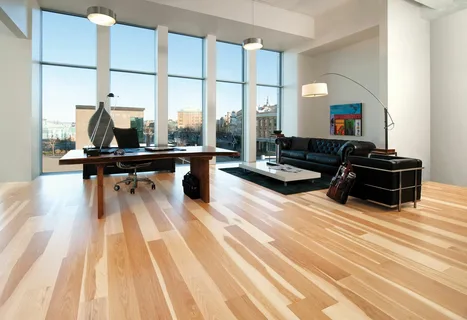
Wooden flooring is not only prized for its timeless beauty and durability but also for its impact on the acoustic environment within a space. From reducing noise pollution to enhancing sound quality, wooden flooring can significantly influence the acoustics of a room. In this guide, we’ll explore the various ways in which wooden flooring affects acoustics, its benefits, and considerations for homeowners and designers.
Understanding Acoustics in Interior Spaces
Acoustics refer to how sound behaves in an enclosed environment. In interior spaces, sound can either be absorbed, reflected, or transmitted, depending on the materials and layout of the room. The goal of acoustic design is to create a balanced and pleasant sound environment by controlling reverberation, minimizing echo, and reducing background noise.
The Role of Flooring in Acoustic Design
Flooring is a crucial component of acoustic design, as it can significantly impact the transmission and absorption of sound within a room. Different types of wooden flooring Dubai materials, such as wood, tile, carpet, and laminate, have varying acoustic properties that affect how sound behaves in a space. Wooden flooring, in particular, is valued for its ability to contribute to a favorable acoustic environment.
Sound Absorption Properties of Wooden Flooring
One of the key benefits of wooden flooring is its natural ability to absorb sound. Unlike hard surfaces like tile or concrete, which tend to reflect sound waves, wooden flooring absorbs sound energy, reducing reverberation and minimizing echoes. This can help create a more pleasant and comfortable environment, particularly in rooms with high ceilings or large open spaces where sound can easily bounce off hard surfaces.
Impact on Noise Reduction
Wooden flooring can also help reduce unwanted noise pollution within a home or commercial space. By absorbing sound waves and preventing them from bouncing off hard surfaces, wooden flooring can effectively reduce the transmission of noise between floors and rooms. This can be particularly beneficial in multi-story buildings or apartments where noise from footsteps, voices, and other activities can travel through floors and walls.
Enhancing Sound Quality
In addition to reducing noise pollution, wooden flooring can enhance the overall sound quality within a room. The natural warmth and resonance of wood can add depth and richness to music, speech, and other audio sources, creating a more immersive and enjoyable listening experience. This is especially true in rooms used for music performance or recording, where acoustics play a critical role in capturing and reproducing sound accurately.
Considerations for Acoustic Design with Wooden Flooring
While wooden flooring offers many benefits for acoustic design, there are some considerations to keep in mind when incorporating it into a space:
- Thickness and Density: Thicker and denser wooden flooring materials tend to offer better sound absorption properties than thinner or lighter options. Consider the thickness and density of the wood when selecting flooring materials for optimal acoustic performance.
- Underlayment and Subfloor: The underlayment and subfloor beneath wooden flooring can also impact its acoustic properties. Adding a layer of acoustic underlayment or insulation between the subfloor and flooring can further enhance sound absorption and reduce noise transmission.
- Room Layout and Furnishings: The layout and furnishings of a room can influence its acoustics. Incorporating soft furnishings like area rugs, curtains, and upholstered furniture can help absorb sound and reduce reverberation, complementing the acoustic properties of wooden flooring.
Maintaining Wooden Flooring for Optimal Acoustics
Proper maintenance and care are essential for preserving the acoustic properties of them. Regular cleaning and maintenance help prevent the buildup of dust, dirt, and debris, which can impact sound absorption and transmission. Avoid using harsh chemicals or abrasive cleaners, as they can damage the finish and surface of the wood. Periodic refinishing and sealing can also help maintain the integrity of the wood and ensure optimal acoustic performance over time.
Conclusion
In conclusion, they can have a significant impact on the acoustics of a room, offering benefits such as sound absorption, noise reduction, and enhanced sound quality. By understanding the acoustic properties of them and considering factors such as thickness, density, and room layout, homeowners and designers can create spaces that are not only visually stunning but also acoustically pleasing. With proper care and maintenance, they can continue to contribute to a comfortable and inviting sound environment for years to come.



